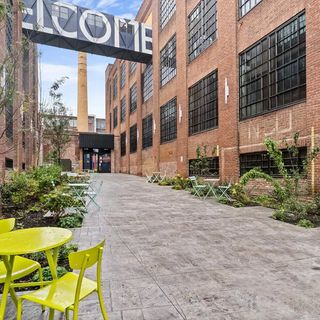The importance of documentation in a historic tax credit (HTC) development cannot be overemphasized. There are actually three distinct forms of documentation, all of which are critical to a successful historic tax credit application.
Historic Documentation:
First is documenting the historic evolution of the building. With few exceptions, buildings change over time. Tenants move in and out. Building system technologies change. Building codes change. The building you see may not at all be like the building it was when constructed. The enclosed ornate stair now functioning as a fire stair may originally have been intended as a design element. The acoustical dropped-tile ceiling installed to hide ductwork when the central air conditioning was installed may obscure an original decorative ceiling and/or door transoms historically intended to provide light and air. And the office with the beautiful classical wood paneling may in fact be a 1980s tenant improvement. The Secretary of the Interior’s Standards for Rehabilitation, which are applied by the state and
federal reviewers to assess the appropriateness of proposed work, take into account the building features that are extant at the start of the development and the importance of those features in conveying a building’s significance. Standard 2 calls for retaining historic materials. Standard 4 addresses the notion that changes over time can become significant. Standard 5 calls for preserving distinctive features. Standard 6 requires deteriorated historic features to be repaired, not replaced. In reviewing HTC applications, the state historic preservation office (SHPO) and National Park Service (NPS) reviewers identify elements in a building that they determine to be character-defining. Yet, in the development process, time is money and developers are usually loathe to waste both on needless research. If a property is listed in the National Register, it qualifies as a certified historic structure. If a property is a contributing building in a historic district and is pretty much as it was at the time the district was listed, the Part 1 certification is not particularly onerous. Yet, many of the early National Register nominations were thin on documentation and most historic district nominations do not critically assess individual buildings in detail. In the end, playing catch-up in a HTC application is a bad idea. Not having the documentation of the building’s evolution conveys the wrong message to the reviewers and undermines arguments that a project meets Standards 2 and 4. Worse, it sometimes results in review delays and in some cases unnecessary conditions or even denials. It is not superfluous to do the homework that thoroughly documents what the building originally looked like but also how specifically it changed over time. This information can be found in archives and building permit offices, but also in thoughtful on-site
investigation combined with an understanding of typical historic materials and the interplay of design with function. Where records may be absent, some of this may be speculation, but logic and thoughtfulness at least conveys to the reviewers that the applicant has considered the issue. This documentation may also be handy in addressing local design review. While the tax credit program allows for sympathetic compatible design (e.g., modern), some communities require designs that harken back to historic conditions–more or less replicating historic design in modern materials. This situation is most common in the installation of new storefronts.
Existing Conditions:
Quite different from documenting how a building has evolved is the documentation of existing conditions. Again, Standards 2, 4, 5 and 6 come into play with the need to preserve, protect and repair historic materials and characterdefining features. Surprisingly often, developers may self-define what is historically important about a building and concentrate design development around those elements–often with unfortunate outcomes. Then too is the practical aspect of paying an architect to drawand document existing conditions when the developer is intently focused on removing those conditions. At the core, an HTC application presents the current state of the building and a proposed new state of the building. The reviewers evaluate whether those changes meet the Standards. Obviously, if the existing conditions are not well documented, the reviewer is at a loss in making the assessment. The onus is on the applicant to provide this information.A standard package documenting existing conditions includes: 1) architectural drawings of all elevations; 2) architectural floor plans for each floor including basement and roof, and 3) comprehensive photographs of the entire building. The intent is to provide the SHPO and NPS reviewers, who are not likely to be familiar with the building, a firm and full grasp–sufficient enough that were he or she to visit the building after reviewing the existing conditions packet, there would be no surprises.In documenting a site, it is also important to know that the HTC program is “old school.” There are many new visual technologies that are effective in documenting a building, including 3-D laser scanners that can provide outstanding computer models. At this point in time, however, state and federal reviews have neither the programmatic or technical capacity to use these technologies. For HTC purposes, documentation remains two-dimensional, reliant on printed plans and color photographs.
Project Documentation:
Slightly different, but still on the theme of taking nothing for granted, is the third area of documentation, project documentation. In recent years, both the development and review processes
have become more complicated. Financial realities encourage HTC applications to be submitted early in the design process, when many of the details have not been resolved. Increasingly, state reviewers send letters requesting additional information but also design changes so a project better conforms with the Standards, while investors want to be sure that the project is properly “papered.” The day of informal conversations with reviewers to resolve development issues is rapidly waning if not already gone. Today, the development file must clearly link project design to the Part 2 narrative and associated Part 2 amendment narratives, and to link submissions with official reviews and determinations. Having a complete and understandable project file for the extended development team has become essential.
Lumber Exchange Building/Roanoke Tower
Many of these themes of documentation, documentation, documentation can be seen in the case of the Lumber
Exchange Building in Chicago. Located on LaSalle Street in the Central Loop, the Lumber Exchange Building was built in three stages: In 1915, Holabird & Roche designed a 16-story terra cotta office building in what has been termed the “Portuguese Gothic” style. Seven years later, the firm added five stories. And in 1926, Andrew Rebori added a telescoping 36-story tower to the east, renaming the building the Roanoke Building and Tower. As an office building, the interior was modified frequently with tenant turnover, morphing from standardized individual offices to variable office suites. In the 1950s, it was modernized and air conditioning installed. In the 1980s, the lobby and exterior ground floor were modernized.In 2007, the property owner embarked on a HTC project. Initially, the scope of work was limited to updating the lobby, upgrading major building systems and modifying office spaces as tenants turned over. At that time, Heritage provided extensively documented existing conditions elevations and floor plans supplemented with some 250 color photographs, including all elevations, storefronts, windows, exterior details, all corridors and office tenant suites on all floors. After initial work on the lobby, major building systems and one floor, the economy slumped and the development was placed on hold. By 2013, changing market conditions resulted in ownership restarting the project and proceeding to adapt the property to hotel use, comprehensively modifying the interior. Given the time lapse, the NPS required an updated set of photographs to document the existing conditions. More importantly, under the previous concept, wholesale changes to the corridors were not anticipated as the redevelopment would move incrementally. Under the current hotel concept, the upper floors were to be treated in a
uniform manner and all the work would be done at once. Heritage now had to address the evolution of corridor
configurations. Historic materials such as marble panels and wood framed doors also became issues as previous building management had economically salvaged and reinstalled vintage materials as tenants changed. The reviewers on the state and federal level both wanted a solid understanding of what was original and what had changed. Finally, the evolution of the project resulted in new partners. These partners properly asked for
documentation that illustrated the history of the project, clearly showing what had been submitted and what had been approved. At the end of the day, solid documentation on all levels resulted in a challenging project progressing. Effort on the front end allayed concerns on the back end. As described by Jeffrey Breaden, senior vice president ofThe Prime Group Inc., “Ten years in the making, the thoroughness of our documentation efforts on the front end allowed us to stay on track and to come to a successful conclusion. Today, the hotel–the 700th Residence Inn with 381 rooms, the largest in the chain–has revitalized the building, strengthened the historic district and activated the streetscape.”








